
Wound Dressings Page Menu: 1 2 3 4 5 6 7 8 9 10 11 Next>>
Wound Dressings in the Golden Age of Piracy, Page 8
Bandaging Elements
The golden age of piracy-era surgeons used several different elements in bandaging. In fact, in a larger sense, everything involved in the process of dressing a wound could be legitimately referred to as a bandaging componenent. However, we are going to focus here on the elements required for external bandaging since we have already discussed the other elements in some detail on the preceding pages.
First we'll look at Cloth and Napkins, then Roller Bandages and we'll finish up with a discussion of splints.
Bandaging Elements: Cloth and Napkins
There were several pieces of cloth used in the creation of an effective external bandage. A glance at the several various forms the Pierre Dionis identifies (on Page 7 of this article) bears this out. Cloth might be wrapped or tied as necessary to cover other dressings or support a part of the body while healing took place. These pieces of cloth might be cut for several reasons as well: to allow access to a wound or or to create tails with which the surgeon could tie them. Little is said in the period surgical journals about the makeup or even the size of these pieces of cloth, although they were likely similar to other bandage elements - made of soft, used, clean materials and cut as needed to fit the application.
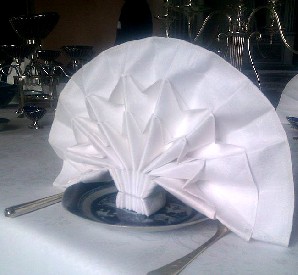
Photo: Kim Bach
No! Not like that! (Well, sort of like that without the folds.)
A more curious reference in various surgical manuals was to cloth napkins. When we think of cloth napkins, we think of the things that sit alongside our plates in nice restaurants. They are usually fairly soft, absorbant and sometimes made of linen. (Depending on which restaurant to which you go, of course.)
These qualities would be relevant to the napkins as well. Although not much detail is given about them, enough appears in a few of the surgical manuals to provide a little insight into the surgical napkins.
In his explanation of the bandages used for a fractured vertebrae, Charles Gabriel Le Clerc notes that the napkin should be made "of good soft Cloth"1. While describing the creation of a sling (which he calls 'a scarf') from 'a great Napkin' for a fractured arm, he provides another insight into their material, although the more interesting comment here may be about the nature of the patient. "This Scarf is made of black Taffety, when the Patient is rich, for he may rise and walk abroad some Days after the Fracture is reduced [restored to its correct position]."2 No doubt black taffeta made for a more distinguished sling than regular old linen!
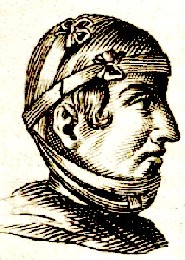
Head Dressing, The Chyrurgeons
Storehouse,
by Johannes
Scultetus,
Table 36 ,p. 156 (1653)
While napkins were used in various dressings, several authors refer to them as being part of the external dressings used following the trepanning of the skull [the drilling of a hole to relieve pressure on the brain.] Pierre Dionis talks about such a dressing as being "a Band rolled up at one end, another of four or five Ells [cubits - the measure from the fingertips to the elbow of a man] long, of the breadth of four Fingers, and roll'd up at both end, in order to make the Bandage which we call the Cap of Maintenance, and several Napkins for necessary occasions."3
Where Dionis suggests a supporting role for the napkin in a post-trepan bandage, Le Clerc makes them the star. He calls for a "large Napkin to make the Bandage, called the Great Cap"4. "To make this,
take a large Napkin more oblong than square; double it length-ways
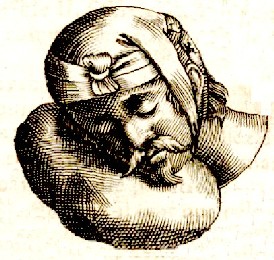
Head Dressing from The Chyrurgeons
Storehouse,
by Johannes Scultetus,
taken from
Table 32 ,p. 112 (1653)
in the middle, and leave one of its Ends four or five Fingers breadth longer than the other: Apply the middle of the Napkin on the Patient's Head, so that the longest side may immediately touch it; Order a Servant to lay his Hand on the Dressings... cause the upper Ends to be held under the Patient's Chin, whilst you take the two lower Ends... and draw them Horizontally on each side, that so you may raise the depending part of the Napkin over the Forehead; then cross the two Ends of the Napkin
which you have hold of behind the Head, that so there may be no Wrinkles; bring them forward, and pin them at their Extremities. In this manner there will remain one End of the Napkin on each Shoulder, which you must handsomely raise over the Head, bringing them near the Eyes and then fasten the two Ends which your Assistant held under the Patient's Chin, either by tying them in a Knot or pinning them. This Bandage, if it be well made, makes a Figure not much unlike a Helmet."5
1 Charles Gabriel Le Clerc, A Description of Bandages and Dressings, p. 59; 2 Le Clerc. p. 29; 3 Pierre Dionis, A course of chirurgical operations: demonstrated in the royal garden at Paris. 2nd ed., p. 410; 4 Le Clerc. p. 5; 5 Le Clerc. p. 5-6;
Absorptive Properties of Napkins
In addition to bandaging, Napkins were commonly used to absorb blood from a wound. When treating a pike wound to the shoulder, John Moyle noted that the wound was healing "and yet Blood still spit up so that several Napkins were wet in 24 Hours; I found it necessary to keep open the Orifice still, to evacuate the Gorie Matter."1 He inserted a tent to allow the 'Gorie Matter' free escape from the wound, determining that "by the fewer Napkins that were stained in a day... the inward extravasated Blood Decreased, and in a few Dressings more it was wholy gone"2.
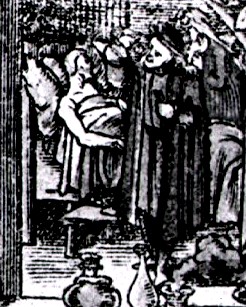
Consultation in a German Herbarium, Title
Page from Krueterbuch Kunstliche
Counterfeytunge der Baume (1569)
Napkins were also used for other medicinal purposes that indicate their absorbant nature. In describing how to make a hot house for sweating the ill humors out of patients on a ship, Moyle advises that once the patient is sweating 'powerfully', "let him have warm Napkins in the bed with him to wipe himself, and have a care that he catch not cold afterward, but cool by degrees."3
In a similar way, Pierre Dionis recommends that when a patient is "in a Lethargy or Apoplexy, he must be laid on his Belly, and after having uncovered his Shoulders they are to be rubbed hard with several very hot Napkins to warm the Parts and draw the greater Quantity of Blood, where we must not forget before-hand to cause a good clear Fire to be made, in order to the frequent renewal of the Napkins"4 in preparation for applying cupping glasses. Cupping glasses were used to draw impurities to the surface of the skin. Dionis further recommends that once the cupping glasses have been applied, get "a very hot Napkin folded several times double, ... clap it on the Cupping-glasses, and a little while after we renew the Application of the Napkin, which we continue on till we think it proper to take off the Glasses, in order to make the Scarifications [the process of making incisions in the skin so that when the cupping glasses are re-applied, they can draw 'bad blood' out of the wound.]"5
1 John Moyle, Memoirs: Of many Extraordinary Cures, p. 57; 2 Moyle, p. 58;3 John Moyle, The Sea Chirurgeon, p. 153; 4,5 Pierre Dionis, A course of chirurgical operations: demonstrated in the royal garden at Paris. 2nd ed., p. 33,
Bandaging Elements: Rollers
"Have in readiness a Rowler of such matter, length and breadth as I shall anon shew you; rowl it up at both ends firmly to the middle; then lay the middle part of the Rowler on that part which is opposite to the Wound, to prevent pain and inflammation." (Richard Wiseman, Of Wounds, Severall Chirurgicall Treatises, p. 343)
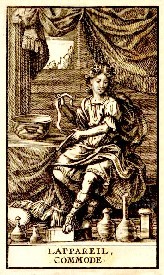
Frontispiece from the French
edition of Le Clerc's book ,
(1700)
Roller bandages were pretty much as we think of them today. They were the primary method for securing plasters, bolsters, medicines and other wound dressings to the body. These workhorses of bandaging are mentioned repeatedly, although casually, by nearly ever period surgical author. However, it is authors Charles Gabriel Le Clerc and Pierre Dionis who provide the most detailed information on the proper use of roller bandages in surgery.
Pierre Dionis explained that a bandage was so tied to its purpose that individual bandages were named according to how they were used. He details several examples, explaining that "those are called incarnative which close the Lips of a Wound; those expulsive, which draw or guide outwards the purulent Matter of Abscesses and Ulcers... As for the first sort [of bandages - which are used to keep medicines on wounds], they are only subservient to Remedies, and they are call’d retentive"1.
While this terminology may have been useful in the Royal Gardens in Paris where Dionis taught, I have not noticed that period authors generally followed the convention. (Thank God for that! Trying to decipher period manuscripts can be hard enough without further confusing it by naming bandages the in the same way as what they were used for!) Still, this does hint at how differently bandages were used and how they might have been applied.
Le Clerc again gives us advice on their makeup, suggesting they they
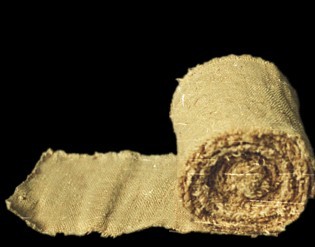
Ancient Egyptian Linen Roller Bandage
"be made of very strong Cloth, for fear they should break, and yet this must not be too new, or stiff... In all Fractures and Luxations, the Rolling ought to be streight [tight], to keep the Bones in their situation, when they are reduced [put into their proper place], and yet not so as to hinder the Circulation, for then the Part will be defrauded of its Nourishment, and there will be danger of a Mortification."2
He mentions two types of roller bandages: single and double. "A Roller is said to have but one Ball or Head, when it is rolled up at one end only, and two when it is rolled up at both."3 So the bandage Wiseman was describing at the start of this section would properly be called a double bandage.
When preparing a roller bandage, how you roll it is important according to Le Clerc. "Whilst you are using [applying] it, the Roller must be as little unrolled as may be, because if much be undone, you cannot be Master of it, which is very troublesome, and it cannot be straightned [tightened] so much as is necessary."4 Anyone who has tried to wrestle with a roller where more than a few inches of the material has been paid out can attest to this!
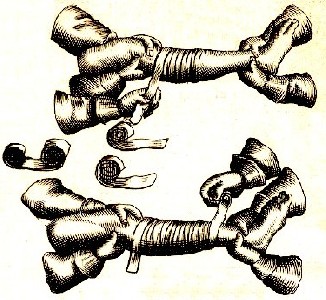
Bandaging the Leg, The Chyrurgeons Storehouse,
by Johannes Scultetus, Table 30,p. 106 (1653)
For the application of the roller bandage, Dionis advises the surgeon as he is beginning, he "must place the Patient in a convenient Posture, that he may cause one or more of his Servants to hold the Part to be bound"5. He then warns the reader to "proceed without hesitation, or giving any Suspicion that he doth not know where to begin."6
All Bandages are not begun and ended in the same manner: Some begin with one of the Extremities of the Band, as those of Fractures; others at some distance from one of its ends, as those of Phlebotomy [bloodletting]; and also by the middle of the Band, when 'tis roll'd at both ends, as the Capeline. Frequently the first part of the Band is plac'd on the Part affected, sometimes on the neighbouring Part; at other times on a distant and opposite Part, and always pursuant to the Intention of the Bandage; but it ought never to be ended upon the Wound, because the Pin which fastens the last Part of it, will not fail to afflict the Patient with the utmost Pain.7
Le Clerc 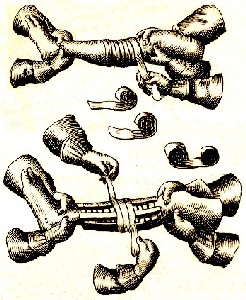
Double and Single Rolling, The Chyrurgeons
Storehouse,
by Johannes Scultetus,
taken from
Table 30 ,p. 106 (1653)
suggests that "[w]hen you begin a Bandage with a Roller with two Balls or Heads, apply the Middle, and let the two Heads be on the upper side of the Roller."8 This is shown in the etching from Scultetus' book at left. Richard Wiseman simply suggests that "after you have made a turn upon the Wound with both ends of the Rowler, to go up with the one, and down with the other, and take so many turns about the Part as may be requisite"9.
Le Clerc continues, "When you roll a Fractured Part, you must never leave it, that is to say, you must keep it with one Hand, whilst you bring the Roller round with the other, and when you shift the Ball from one Hand to another, you must have the other Hand on the Part, and do this alternately, for fear lest the Bones should slip out of their place if they were not supported."10 This would be true for both double- and single-headed rollers.
Le Clerc gives another tip. "When you make use of a Roller with two Heads and would pass one end of it over the other to make Rounds on the Part, you must unroll a great deal, that so stretching it a great way, one end may go over the other smoothly, and by this means the place where the two ends of the Roller pass over one another cannot be discerned, and the Rounds will be very neat."11 (Le Clerc is a stickler for neatness as we will soon see.)
Similarly, Dionis recommends that the bandage "be hard roll'd up, so even the Convolutions exactly cover one another like concentrical Rings; [taking the bandage] in one hand, and holding the first part of it in the other... [the surgeon] ought, with equal Diligence and Exactness, to surround the Part affected with the Band."12
Le Clerc works quite hard to describe effective rolling techniques. For example, he explains how to effectively roll a part "of an unequal Thickness, as the Leg for Instance, which is bigger about the Calf than in the Small"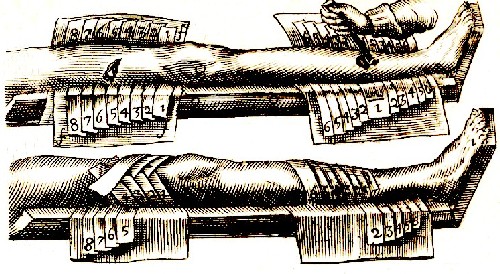
Graduated Leg Bandaging, from The Chyrurgeons
Storehouse,
by Johannes Scultetus,
taken from
Table290 ,p. 74 (1653)
13. A problem Le Clerc identifies is that on each round, 'a sort of Pocket' (or a gap) forms. Le Clerc suggests to avoid this the surgeon must "make a Reflexion, where this would happen, That is, lay your Finger on
the Roller where you would bring it back [around the part], then turning your Hand, by a Pronation [rotating movement of your forearm] of it make a Pleat... this is called a Reflexion, and [it] is to be done once in every Turn while the part continues to lessen, unless you shall rather chuse to guard the Part with circular Compresses graduated."14 As extraordinarily painstaking as making individually-sized compresses sounds, some period surgical authors show diagrams on how to do just that.
Once the bandaging is completed, Dionis recommends re-examining the work, making sure that "the Circumvolutions are securely and equal[ly] made; whether it be neither too laxe nor too hard, and whether well adapted to the Form and Substance of the Part: Then he place the Part in such manner on Cushions, that it remains firm and free from Pain;
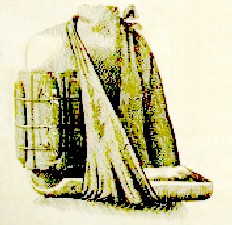
Arm in Sling from A General System of
Surgery
by Lorenz Heister, Plate 38 (1750)
observing, as a general Rule, that the Posture of the Arm be somewhat bent, and the Leg wholly extended."15
Ambroise Paré makes a related observation with regard to binding an arm which expands upon the reasoning behind it. "On the contrary the Arm or Elbow must be bound up, bending in and turned to the breast, for otherwise at the first bending, if it be bound when it is stretched forth, the Ligature will be slacked, for that (as we formerly said) the figure of the muscles is perverted. Now for this indication, let each one perswade himself thus much, that the part must be bound up in that figure, wherein we would have it remain."16
Le Clerc gives a rather interesting warning to the reader: "When the Rollers have imbibed much of the Pus [after being on a wound], you must put them in a Bucket, and not dry them at the Fire, as is done in some Hospitals, for this is a dangerous Practice for the reasons above mentioned. [He explained elsewhere that 'it is impregnated with several Acids from the Wound, which will re-enter it, and increase the Malady.']"17
Of course, on a ship the surgeon may not have always had the luxury of being able to use new roller bandages when the old ones became soiled - particularly since at this time, the role of germs were not understood. We can only hope that he had the means to clean them rather in addition to just drying them.
1 Pierre Dionis, A course of chirurgical operations: demonstrated in the royal garden at Paris. 2nd ed., p. 33; 2 Charles Gabriel Le Clerc, A Description of Bandages and Dressings, p. 4; 3,4 Le Clerc, p. 5; 5,6,7 Dionis, p. 33; 8 Le Clerc, p. 6; 9 Richard Wiseman, Of Wounds, Severall Chirurgicall Treatises, p. 343; 10Le Clerc, p. 6; 11 Le Clerc, p. 5-6; 12 Dionis, p. 33;13,14 Le Clerc, p. 6; 15 Dionis, p. 33-4; 16 Ambroise Paré, The Apologie and Treatise of Ambroise Paré, p. 361; 1Le Clerc, p. 8

